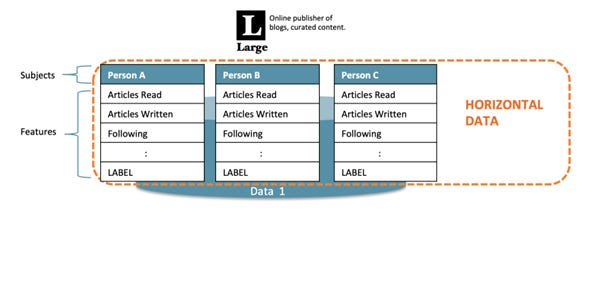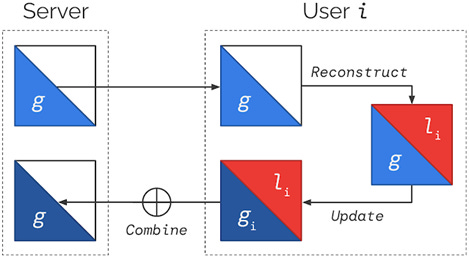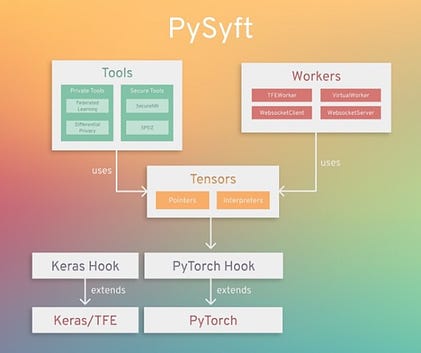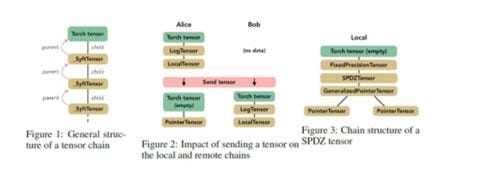TheSequence - Edge 273: Horizontal Federated Learning
Was this email forwarded to you? Sign up here Edge 273: Horizontal Federated LearningHorizontal federated learning, Google’s research on personalized federated learning Syft framework.In this issue:
💡 ML Concept of the Day: Understanding Horizontal Federated LearningIn the previous edition of this series, we introduced a taxonomy to understand the different types of federated learning architectures. Today, we would like to dive into one of the most relevant architectures in that taxonomy: horizontal federal learning(HFL). Conceptually, HFL is a type of architecture in which the datasets distributed across all nodes in the federation share the same feature space but different sample space. For instance, imagine a federated learning model applied to a group of social networks or blogging platforms. While the feature set of the dataset is relatively identical, there might be very small interception points across the sample based. Not surprisingly HFL is also known as sample-based federated learning or homogeneous federated learning. Google’s architecture proposed in the original federated learning paper could be considered HFL as the feature space across the different Android users was common but the users were obviously different. HFL architectures typically consists of large number of nodes that produce different types of updates in terms of volumes or data distribution. Those results are aggregated by a centralized server and the updates distributed back to the nodes. One of the interesting architectures derived from HFL is known as multi-task federated learning in which different nodes are optimized to master different tasks and share the updates with the rest of the federation. 🔎 ML Research You Should Know About: Personalized Federated Learning
Why it is so important? The method unveiled in this research addresses one of the most important privacy challenges in federated learning architectures and has been applied at scale in platforms like GBoard. Diving Deeper: Most federated learning architectures relied on training a global model based on the parameters captured by different nodes in a federation. However, in many scenarios, there are strong privacy considerations that prohibit learning a fully global model. For instance, many recommendation systems might require access to individual user’s embeddings for training which might not be an option in different privacy settings. In their research, Google pioneered a method known as federated reconstruction that avoids sharing a subset of sensitive parameters with the centralized server. The key contribution of the federated reconstruction technique is that it avoids storing the parameters locally and, instead, it can reconstruct them whenever required. During training, the global parameters are sent to each node which “freezes ” that dataset and infers the local parameters using gradient descent. After that they can update the global parameters using a frozen representation of the local parameters. The following picture illustrates a round of the federated reconstruction algorithm. Google’s applied the federated reconstruction algorithm in several large scale system such as GBoard. In that specific setting, federated reconstruction was used in a matrix factorization model keeping the user’s embeddings locally. The method was applied across hundreds of millions of users with impressive results. 🤖 ML Technology to Follow: Syft Combines Federated Learning and Privacy in a Single FrameworkWhy should I know about this: Syft is one of the most advanced frameworks in the market for building private federated learning models. What is it: Syft is a framework that enables secured, private computations in federated learning models. Syft combines several privacy techniques such as federated learning, secured multiple-party computations and differential privacy in a single programming model integrated into different deep learning frameworks such as PyTorch, Keras or TensorFlow. The principles of Syft were originally outlined in a research paper and were then implemented in its open source release. In simple terms, Syft allows to query a dataset within strong privacy boundaries. The core component of Syft is an abstraction called the SyftTensor. SyftTensors are meant to represent a state or transformation of the data and can be chained together. The chain structure always has at its head the PyTorch tensor, and the transformations or states embodied by the SyftTensors are accessed downward using the child attribute and upward using the parent attribute. Syft rich collection of privacy technique represent a unique differentiator but even more impressive is its simple programming model. Incorporating Syft into models in Keras or PyTorch is relatively seamless and it doesn’t require deviating from the core structure of the program. Is not a surprise that Syft has been widely adopted within the deep learning community and integrated into many frameworks and platforms.
You’re on the free list for TheSequence Scope and TheSequence Chat. For the full experience, become a paying subscriber to TheSequence Edge. Trusted by thousands of subscribers from the leading AI labs and universities. |
Older messages
What a Week for Generative AI
Sunday, March 12, 2023
Sundays, The Sequence Scope brings a summary of the most important research papers, technology releases and VC funding deals in the artificial intelligence space.
Edge 272: Inside Toolformer, Meta AI New Transformer Learned to Use Tools to Produce Better Answers
Thursday, March 9, 2023
The model mastered the use of tools such as calculators, calendars, or Wikipedia search queries across many downstream tasks.
A Taxonomy to Understand Federated Learning
Tuesday, March 7, 2023
Classifying different types of federated learning methods, Meta AI research about highly scalable and asynchronous federated learning pipelines and Microsoft's FLUTE framework.
ChatGPT and Whisper APIs
Sunday, March 5, 2023
Sundays, The Sequence Scope brings a summary of the most important research papers, technology releases and VC funding deals in the artificial intelligence space.
📝 How is MLOps more than just tools?
Friday, March 3, 2023
Hi there! At TheSequence, we're exploring what MLOps culture looks like across the industry at the start of 2023. A huge variety of tools are available for ML development, but the culture and
You Might Also Like
Import AI 399: 1,000 samples to make a reasoning model; DeepSeek proliferation; Apple's self-driving car simulator
Friday, February 14, 2025
What came before the golem? ͏ ͏ ͏ ͏ ͏ ͏ ͏ ͏ ͏ ͏ ͏ ͏ ͏ ͏ ͏ ͏ ͏ ͏ ͏ ͏ ͏ ͏ ͏ ͏ ͏ ͏ ͏ ͏ ͏ ͏ ͏ ͏ ͏ ͏ ͏ ͏ ͏ ͏ ͏ ͏ ͏ ͏ ͏ ͏ ͏ ͏ ͏ ͏ ͏ ͏ ͏ ͏ ͏ ͏ ͏ ͏ ͏ ͏ ͏ ͏ ͏ ͏ ͏ ͏ ͏ ͏ ͏ ͏ ͏ ͏ ͏ ͏ ͏ ͏ ͏ ͏ ͏ ͏ ͏ ͏ ͏ ͏ ͏ ͏ ͏ ͏ ͏
Defining Your Paranoia Level: Navigating Change Without the Overkill
Friday, February 14, 2025
We've all been there: trying to learn something new, only to find our old habits holding us back. We discussed today how our gut feelings about solving problems can sometimes be our own worst enemy
5 ways AI can help with taxes 🪄
Friday, February 14, 2025
Remotely control an iPhone; 💸 50+ early Presidents' Day deals -- ZDNET ZDNET Tech Today - US February 10, 2025 5 ways AI can help you with your taxes (and what not to use it for) 5 ways AI can help
Recurring Automations + Secret Updates
Friday, February 14, 2025
Smarter automations, better templates, and hidden updates to explore 👀 ͏ ͏ ͏ ͏ ͏ ͏ ͏ ͏ ͏ ͏ ͏ ͏ ͏ ͏ ͏ ͏ ͏ ͏ ͏ ͏ ͏ ͏ ͏ ͏ ͏ ͏ ͏ ͏ ͏ ͏ ͏ ͏ ͏ ͏ ͏ ͏ ͏ ͏ ͏ ͏ ͏ ͏ ͏ ͏ ͏ ͏ ͏ ͏ ͏ ͏ ͏ ͏ ͏ ͏ ͏ ͏ ͏ ͏ ͏ ͏ ͏ ͏ ͏ ͏ ͏
The First Provable AI-Proof Game: Introducing Butterfly Wings 4
Friday, February 14, 2025
Top Tech Content sent at Noon! Boost Your Article on HackerNoon for $159.99! Read this email in your browser How are you, @newsletterest1? undefined The Market Today #01 Instagram (Meta) 714.52 -0.32%
GCP Newsletter #437
Friday, February 14, 2025
Welcome to issue #437 February 10th, 2025 News BigQuery Cloud Marketplace Official Blog Partners BigQuery datasets now available on Google Cloud Marketplace - Google Cloud Marketplace now offers
Charted | The 1%'s Share of U.S. Wealth Over Time (1989-2024) 💰
Friday, February 14, 2025
Discover how the share of US wealth held by the top 1% has evolved from 1989 to 2024 in this infographic. View Online | Subscribe | Download Our App Download our app to see thousands of new charts from
The Great Social Media Diaspora & Tapestry is here
Friday, February 14, 2025
Apple introduces new app called 'Apple Invites', The Iconfactory launches Tapestry, beyond the traditional portfolio, and more in this week's issue of Creativerly. Creativerly The Great
Daily Coding Problem: Problem #1689 [Medium]
Friday, February 14, 2025
Daily Coding Problem Good morning! Here's your coding interview problem for today. This problem was asked by Google. Given a linked list, sort it in O(n log n) time and constant space. For example,
📧 Stop Conflating CQRS and MediatR
Friday, February 14, 2025
Stop Conflating CQRS and MediatR Read on: my website / Read time: 4 minutes The .NET Weekly is brought to you by: Step right up to the Generative AI Use Cases Repository! See how MongoDB powers your






